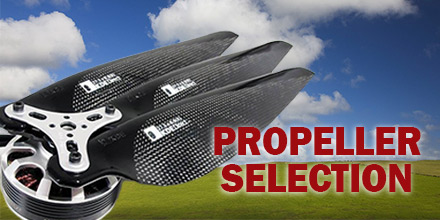Choosing the Optimal Propeller Blade
 To choose the optimal drone propeller blade, the user should consider a number of factors.
To choose the optimal drone propeller blade, the user should consider a number of factors.
Drone propeller blades have a significant influence on power and affect how smoothly a drone flies.
As such, flight efficiency is one of the most important considerations. It begs the question, how will new drone propeller blades improve the flight efficiency of your multi-rotor UAV?
When selecting new drone propeller blades, the following factors are important considerations:
Number & Size of Blades
The number of blades required per propeller will vary depending on the platform, usage and payload requirements.
Drones for racing and acrobatics most frequently use smaller blades, under eight inches. Smaller blades are generally paired with smaller motors with high kV ratings.
Larger blades, over eight inches, are paired with motors that have low kV ratings. These blades are used to carry heavier payloads, such as video equipment or spraying containers for agriculture.
Pitch
Pitch is defined as the traveling distance per a single revolution of the propeller. The correct pitch will often depend on the specific application for a UAV platform.
Lower pitch often results in more torque and less turbulence for lifting. As a result, the motors do not have to work as hard to carry heavy payloads. And, since the motors draw less current from the battery, it results in increased flight time.
Propellers with higher pitches move more air but generally create more turbulence and less torque.
Diameter
Typically, a larger diameter propeller blade allows greater contact with the air. This relates directly to flight efficiency, as a small increase or decrease in diameter can change how efficiently a drone performs.
In comparison to smaller propellers, larger propellers tend to provide more stability when hovering.
However, smaller propeller blades require less effort to speed up or slow down than larger ones. This makes smaller blades more responsive than larger propellers.
Smaller propellers with a high pitch are better suited for fast and quick maneuvers. Larger propellers with low pitches are more appropriate for carrying heavier payloads and aerial video cameras.
Additional considerations
- Blade material
- Power
- RPM
- Air density
- Maximum noise
In summary, selecting the most appropriate propeller blades depends on the planned use as well as additional factors. Understanding how propeller blades effect drone performance helps remove some of the guess work.

